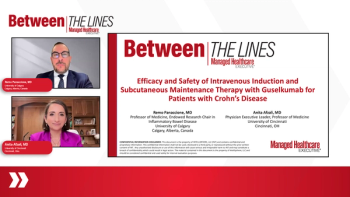Articles by Anita Afzali, MD

Panelists discuss how the GALAXI trials’ limitations include exclusion of patients with penetrating/stricturing disease and perianal fistulizing disease and pediatric populations, while emphasizing key takeaways for different stakeholders: Patients can expect strong symptomatic relief with endoscopic healing and excellent safety, providers gain a rigorously-tested first-line treatment option with evidence-based positioning in treatment algorithms and payers should recognize the high-value therapy with potential long-term cost savings through durable remission and reduced disease complications.

Panelists discuss how guselkumab demonstrated a very reassuring safety profile with no new safety signals or unexpected adverse events compared with placebo and consistent with safety data from other disease indications, requiring no different monitoring protocols than standard care for Crohn’s disease patients on advanced therapies, while emphasizing that uncontrolled disease itself represents the biggest safety concern.

Panelists discuss how the GALAXI trial results demonstrated guselkumab’s durability, efficacy, rapid onset and clean safety profile with superiority over ustekinumab across most objective end points, including endoscopic response and deep remission. The clinical and endoscopic end points align with STRIDE-2 treatment targets and translate to meaningful patient outcomes, including symptom resolution and reduced future hospitalizations, surgeries and disease flares.

Panelists discuss how the GALAXI trials enrolled a broadly generalizable population of adults with moderate to severe Crohn’s disease (CDAI 220-450) requiring objective evidence of active inflammation, including both bio-naive and bio-experienced patients with approximately 40% to 50% having previously failed advanced therapies, although patients previously exposed to ustekinumab or other p19 inhibitors were excluded due to the active comparator design.

Panelists discuss how the GALAXI-2 and GALAXI-3 trials represented a landmark study design for Crohn’s disease research through their rigorous triple-dummy active comparator methodology, treat-through model without rerandomization, inclusion of both bio-naive and bio-experienced patients, composite primary end points measured at individual patient levels, and the unique ability to conduct pooled analyses comparing guselkumab directly with ustekinumab as an active comparator.

Panelists discuss how the expanding treatment landscape for Crohn’s disease includes multiple mechanisms of action such as anti-tumor necrosis factor (TNF) agents, anti-integrin agents, interleukin inhibitors, and Janus kinase (JAK) inhibitors, with particular focus on guselkumab’s unique dual-acting mechanism as an IL-23 p19 inhibitor that also reduces CD64 expression on intestinal macrophages, although the clinical significance of this dual action compared with other p19 inhibitors remains to be fully determined.

Panelists discuss how maintaining patients on effective single therapies for Crohn’s disease is preferable to switching between different mechanisms of action, while addressing access challenges created by insurance step-therapy requirements and biosimilar policies that can interfere with optimal treatment selection.





